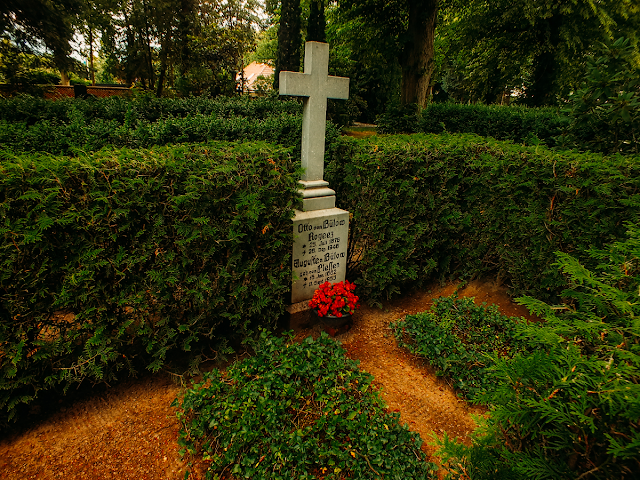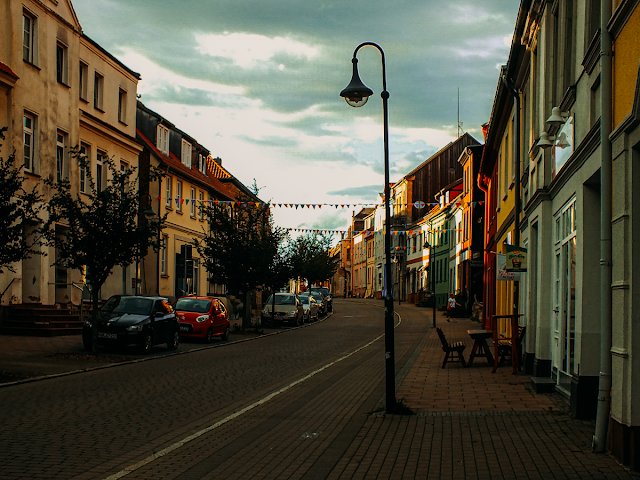a great sitting spot on lake malchow, you can see the ruins of the becker & haese textile mill, which is why i believe i shot this image from the island district.
in autumn of 2019 my parents and i visited a little town in the region of the mecklenburg lake plateau called malchow - and were so charmed by it that we vowed to return someday! this return happened almost a year later in the summer of 2020 and today is finally the day i will start telling you all about this vacation - more views and insights into the town and eventually all the little adventures we had in the surrounding landscapes! my post on our first visit to malchow is pretty extensive and filled to the brim with information and musings already, and i actually advice y'all to re-read it and enjoy the different atmosphere of this town in autumn! i think the post in itself is one of my favourites of all time, i mused about so many things and fawned a whole lot over the whole cityscape 😍
returning to malchow in the summer was a wonderful experience, too and with warmer temperatures this time we eventually got around to swimming in lake malchow as well! though of course, in true northern german fashion, there were a few rainy days thrown in for good measure. but that didn't deter us from exploring, no, because fun can be had in every weather and gives great opportunities for a good variety of motives, right?
we arrived in malchow in the late afternoon and after we settled everything in our appartment in the 'new town', we immediately set out for our first evening walk, which took us to the east side of the lake, where the abbey is situated. to get there, we had to pass the old city core, which you'll maybe remember is situated on an island, and then you pass by the dam that connects the convent with the island. you'll eventually end up at the quai in front of the abbey church and can enjoy the views over the lake towards the main town!
looking up at malchow abbey. again, we've never made it inside the church. it would have been possible during a super rain day, but since the corona epidemic was in full swing, we avoided all kinds of indoor activities. the abbey was once a cistercian nunnery and after the reformation a convent for noblewomen. the oldest buildings on the site date back to around 1300 ( the dormitory & refectory - not seen here ). for more insight into the rest of the abbey buildings, my first post on malchow includes more explanations and pictures ;)

we focused instead on the glittering waters of lake malchow and strolled along its shores towards engel'scher garten - a little park that was once only for the enjoyment of the canonesses but now is open for the public.
the lake has an elongation about 5 kilometers and borders the fleesensee in the east and the petersdorfer see in the west, and the river that connects all these lakes is called elde.
we watched cormorants start into the depths of the lake to fish.
dramatic skies over the lake.
view back towards the abbey church. i adore the little shore-side houses and wish they were tiny houses i could live in ;)
around the corner of this building was an old kitchen garden - on our last visit the year prior i took a few photos there. many of the canonesses' living quarters had adjacent gardens for their perusal, and of course they had to have depositories for their garden utensils and wood that they used for keeping their apartments warm and their ovens cooking. all of that was stored inside these shore-side buildings.

slowly we approached the engel'sche garten. there are many old trees inside this little park and i enjoyed how, with their green leaf crowns, they hovered over our heads protectively.
the tree of knowledge & and the tree of wisdom fused together. love that symbolism so much!
one last glance back towards the water, admiring the wooden boat sheds.
next, we passed by the cemetery of the convent, which was also used for people living in the village surrounding the abbey. these days it's not used for burials anymore and it is planned to restore it into a more park-like structure. i loved the brickstone enclosure, something about the patterns that is super aesthetic for me.
this weird beech tree is apparently under nature protection, but i could not find any detailed information on its age. but what an exceptional form it exhibits! super love ❤
one can only wonder what happened to this tree, it's as if in its early days there must have been another tree growing on top of it and they grew together and then eventually pushed the other tree up or something. a freak of nature!
the cemetery's chapel, was first built in 1819 as a mortuary, but turned into a chapel 40 years later. the cemetery itself exists since 1818 and got erected after the practice of burying the dead haphazardly for centuries around the monastery grounds. it's of neoclassical design.
many of the nunnery's canonesses were buried on these grounds.
the last domina ( or abbess ) of the convent, gertrud von lücken, found her rest here of course as well. there was a little photo of her, but i failed to take a shot. thank goodness there is the world wide web and i could find her picture here. she died in 1972 and turned nearly 100 years old! secretly i sometimes think, living in a convent might be an ingredient for living a long life ;D must have something to do perhaps with being sheltered from the influence of men and everday's grievances and harms. though of course i know that convent women are not beyond living every facette of life like the rest of us.
the von lückens are an old mecklenburgian noble family that dates back to the 13th century. unfortunately i couldn't find much information on gertrud, but it seems she was widely respected during the time she lived and managed the convent ( which was almost 30 years ). after she died, the history of the monastery/convent ended after exisiting for 400 years.
more gravestones, probably all of former conventuals.
the people of malchow do honorary work on these graves, taking care of them and keeping them tidy and proper. this memorial is actually a gravestone for ursula freifrau von roenne, the wife of colonel alexis freiherr von roenne. alexis, who was part of the wehrmacht abwehr ( intelligence service ) was complicit in the assassination plans against hitler on july 20 1944 and arrested and murdered after the whole undertaking failed. he only turned 41 years old.
otto von bülow rogeez & auguste von bülow, the parents of ursula. the bülow family is a widely ramified nobility, i had serious trouble finding anything about the rogeez lineage, though. i guess they were pretty minor nobility ( as the little village actually suggest that they took the name from - apparently today it only has about 300 inhabitants ).
i loved this little conglomeration of gravestones. they looked a little cast aside. they tell of a loved son and an apothecary.
more haphazardly thrown around gravestones. i hope they eventually find a nice spot and some caretaking 😢.
the brickstone main gate of the cemetery. it was built in 1844, probably after plans by friedrich wilhelm buttel, a master builder for the state of mecklenburg-strelitz. he built the abbey church as well!
a lot of the buildings in and around the former monastery showed similar building style, so i would almost think that buttel had his hands on a lot more projects there and indeed, he was responsible for them! this barn was formerly a horse stable ( 1861 ). it was attached to some smaller sheds that were built for the conventual ladies.
this blue door / curtain in the window situation was pretty charming 💙
inside this building- the terraced house - there had once been apartments for the convent ladies - exactly 4 of them, as the doors suggest. back when they were built around 1849 they had been quite comfortable 2-storied living spaces! every conventual also had one of the little garden houses on the other side of the street, behind which a little garden would hide that was only for them to use.
today, the building is also used as an accommodation unit, but i think it was subdivided into more apartments than just 4.
the sheds were used as storage where the ladies could store their tools for garden work or wood and fuel for their apartment keeping. behind these, their own personal gardens were situated. somehow i would've liked a little peek inside them, too, as a fellow garden lover ;)
the front gates miss a little oomph these days! someone should decorate them and plant some flowers or put up flower pots! instant charmification!
the rear side of the terraced houses. it almost had a little bit of new objectivity vibes going on ( which is something i noticed in my other post, too 😅 )
back to the abbey church! its neo-gothic facade is still very beautiful to look at!
an old duplex building i loved on the street towards the abbey. it is on the list of protected monuments in malchow, but unfortunately no other info can be found on the origin of it. well then, i'm just gonna enjoy it and its half overgrown facade!
after this little exploration we made our way back over the island to our holiday flat. these fire protection streets on the city island were erected after a few bad fires went rogue in the old times to stop the fire from spreading uncontrollably. usually you can walk right down to the shores, which gives it another purpose - enjoyment of the lake :)
waved a quick hello to the former district court ( built in 1881 ) - another grandiose brickstone building in malchow 😍
we crossed the turning bridge of course, which provides you with a nice view towards the abbey and its surrounding buildings. the modern building on the left is part of the hotel rosendomizil - a pretty chic boutique hotel! it has a restaurant and cafe attached to it also looking out at the lake. we never tried it out ( still thanks to corona restrictions ) but if i ever come back to malchow, i would kinda like to! it looks like a sweet place to be for a while and enjoy some culinary delights!
the street on which our holiday flat was in. i really liked the brightly coloured bunting everywhere. the evening sun was also beautiful.
 i heard little chirping noises while we walked back to our place and when i looked up, this little swallow fellow was hanging out on an old lamp ❤ it's a barn swallow - one of human's favourite birds, since they keep annoying insects away! swallow-friendly houses are widely welcomed here in germany, it's also said they bring good luck!
i heard little chirping noises while we walked back to our place and when i looked up, this little swallow fellow was hanging out on an old lamp ❤ it's a barn swallow - one of human's favourite birds, since they keep annoying insects away! swallow-friendly houses are widely welcomed here in germany, it's also said they bring good luck!there's gonna be more explorations through malchow soon, but also other adventures. it was nice to be back in this exceptional idyllic part of germany, the mecklenburg lakeland is always worth a visit!








































Comments